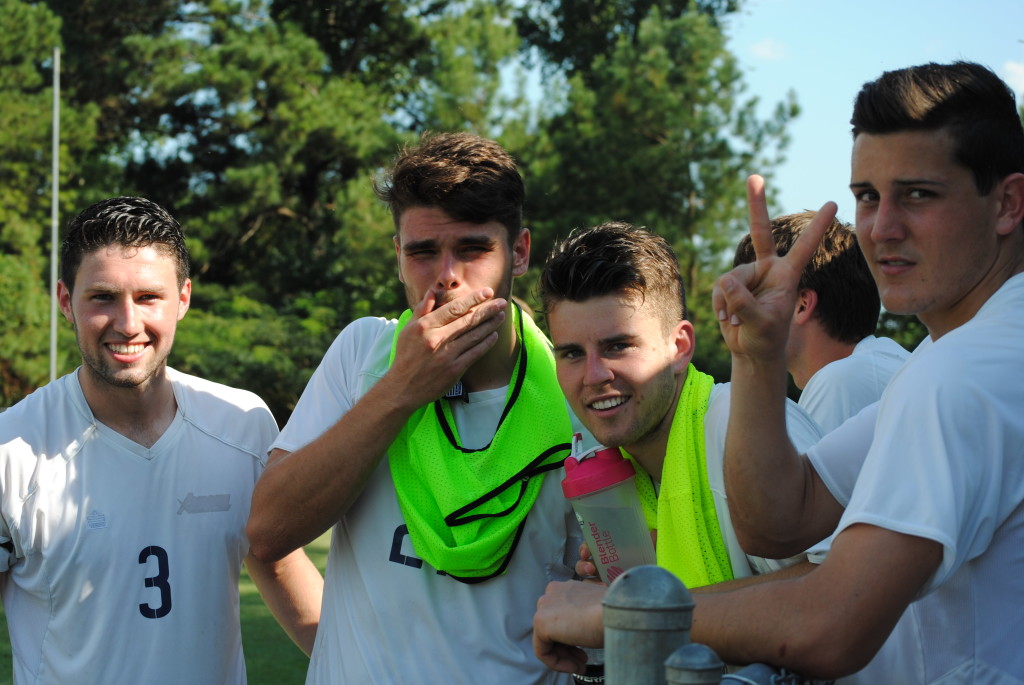Welcome to Interview #52.
I am pleased to share with you the wisdom of NJCAA Soccer Coach of Andrew College, Rudy Roediger.
Rudy Roediger has wealth of diverse experiences which really show through in the wisdom he shares with us.
Whether you are looking at two year or four year colleges, this is a must read. This is one of the most thoughtful and helpful interviews I have done to date.
He has a uniquely diverse resume as a coach, technical director, athletic director, director of operations, sports information director and director of media relations at the interscholastic, intercollegiate, Premier Development League, Olympic Development Program, club and international levels.
Coach Roediger’s full bio is at the end of the interview.
How do you find players for your team? What type of student and athlete do you focus on?
We have a variety of ways we identify prospects. First we listen to our players both current and former. And for me that means former players I coached at other schools. At Andrew we have a wonderful network of former players around not only the Southeast United States but around the world who played at Andrew College over the last 41 years. I listen to these guys when they call me about a potential player. In fact we look to have several guys join us this fall who all have direct ties to former players.
Additionally I have a wonderful network of individuals I trust around the country and the world that I have worked with over the course of coaching at the club, high school and college ranks. These are guys that will call me or that I call to see who they feel I should look at. I also keep close relationships with four-year coaches and I get calls from some who have a guy that needs to come to the NJCAA for a year or two for whatever reason.
There are always the trips to showcase events, identification camps, tournaments and club and high school matches where I go “fishing” or in other words looking to see what I can find with little or no lead. In the last 16 months I’ve traveled about 30,000 miles to events in 11 different states (Alabama, Florida, Georgia, Louisiana, Mississippi, North Carolina, Ohio, South Carolina, Tennessee, Texas, Virginia) and there are still many miles left before the summer months so that number will just grow.
We try to cast as wide a net as possible to find the right guys because that is the biggest thing in building a college program, having guys of high character. We look for “OKG’s” (Our Kind of Guys). These are guys who are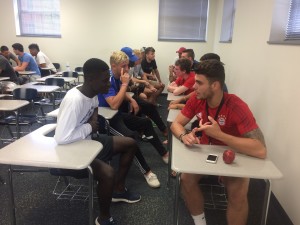 good citizens, who are good students and are good soccer players. It takes a special person to be exceptional at anything. Not everyone has the mindset to be a high-level student-athlete. We look for guys who are humble and hungry to be the very best student-athlete they can be. When we get down to specifics I like versatile guys who are good at more than one position. Getting the right ingredients isn’t always easy and you never know what the cake will taste like till you begin to bake it in the fall during preseason.
good citizens, who are good students and are good soccer players. It takes a special person to be exceptional at anything. Not everyone has the mindset to be a high-level student-athlete. We look for guys who are humble and hungry to be the very best student-athlete they can be. When we get down to specifics I like versatile guys who are good at more than one position. Getting the right ingredients isn’t always easy and you never know what the cake will taste like till you begin to bake it in the fall during preseason.
Why do you think athletes should consider a NJCAA (National Junior College Athletic Association)? What are the benefits of an NJCAA school specifically?
The greatest benefit to playing at an NJCAA school is simply everyone on the roster are of similar ages. Everyone on the squad will be freshman or sophomores so the disparity in a physical sense that you see at a four-year college or university are not there as much.
Guys get to learn more by playing, and for us we try to only bring in players who we see as playing for us in the first year or maybe two. Being able to get on the pitch as a freshman or sophomore isn’t always the case and more often than not it’s not at four-year schools. We want our guys to leave as impact players for a four-year school. This means they need to play to truly develop as a soccer player to the fullest potential in two-years.
What effect does social media have on your recruiting? Can you talk about players who you have either stopped recruiting or become more interested in based on their social media use?
Social media can have a big impact on what we do or don’t do with a prospect. I’ve greatly reduced scholarships before I make the offer and even pulled an offer off the table if I see things that do not represent the college, alumni or our program. Social media can be such a positive avenue. But it has the potential for showcasing individuals in a very poor light. If prospects are not mature in what they say or what they post then it is a warning sign of future problems.
Could you share, in whatever detail you are comfortable, what the athletic scholarship break down looks like on your roster?
Simply the NJCAA only allows 18 players to receive any sort of athletic aid. With our roster this fall of 26 guys, this will mean at least eight will not be on athletic money. Also we do not offer full athletic scholarships and I see this as strength as most colleges do not offer an abundance of full athletic scholarships.
Andrew College offers an academic competition where two students win full scholarship for the two-years they are here. Last year we had six prospects take part in this competition and it’s always a goal to get as many guys in to the competition as possible. I always look to help the player get the best institutional package possible and then show them outside resources for scholarships and grants. College is an investment and there are lots of resources out there that many people don’t know about.
On your current roster, you have six players from foreign countries plus the United States. Can you talk about how you recruit international players?
I’ve always enjoyed having guys with different backgrounds on my teams. I like players with different styles of play, plus it’s always enjoyable to learn more about different places around the world. Now with four guys who have been called into the British Virgin 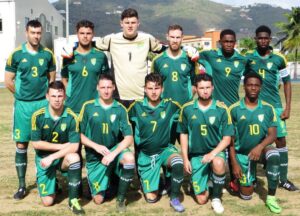 Islands national team for the Caribbean Cup in a few days from now has led us to being an attractive place for other internationally experienced or aspiring players.
Islands national team for the Caribbean Cup in a few days from now has led us to being an attractive place for other internationally experienced or aspiring players.
Working through the process can make for some very long days, but it is very rewarding. Last year when I was working with a variety of international prospects I would be up at 3 a.m. to speak with a guy who was 16 hours ahead, then I would speak with another at 5 a.m. who was five to six hours ahead. I would take a “nap” till 10 a.m. when I would go in to the office.
Truly during that time I wasn’t sleeping much and when I did it was some strange hours. I always ask guys to tell me what time (their time) that they are free to speak. Then I go in to my phone where I have over 20 different time zones from more than 20 countries to see what time I would need to call them. The point here is I speak with every prospect by phone if I can’t talk to them in person.
What advice do you have for international players who want to play at a college in the U.S.?
That it’s not as easy as some would think. The American soccer game has greatly improved in just the last five or so years not to mention 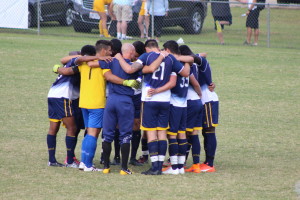 since I was a kid. The college game continues to get better every year as well. We haven’t really seen the issue but I know sometimes there is a perception that being a player from another country will automatically make them the best player just because they are not American.
since I was a kid. The college game continues to get better every year as well. We haven’t really seen the issue but I know sometimes there is a perception that being a player from another country will automatically make them the best player just because they are not American.
Everywhere in the world is talent and guys who are not so talented and that includes the American players. The NAIA Women’s Soccer National Champion in 2015 didn’t have a single international player and beat two teams on the way to the championship that by in large didn’t play a single American player. That’s just one example.
What does the offseason, fall season and summer look like for a NJCAA soccer player?
Busy. We have a summer training packet that lasts 10 weeks before the guys report for preseason.
During the fall we train and play six days a week with around 19 to 22 matches and exhibitions and training is focused on the team and preparing for the next opponent or correcting something from the previous match.
In the spring we do things a bit different, when the guys report back to school we do fitness and weight testing and training till we are allowed to get back on the field. Once we are back on the field we mix things up with small sided matches on Monday and Wednesday with Friday being full sided 11 v 11 intersquad matches. Tuesday and Thursday we do functional training that focuses on the players and where they need to improve to be better players in their positions
Also in the spring we have the weight room open and accessible through the entire week. But guys are required to follow our weight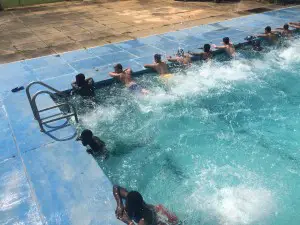 training program. A few guys take part in more than one session on these shortened and intense days. Once we get closer to our four spring exhibition dates then we get back to team training like we would in the fall.
training program. A few guys take part in more than one session on these shortened and intense days. Once we get closer to our four spring exhibition dates then we get back to team training like we would in the fall.
In the spring we have flexibility to play a variety of opponents. This spring we host both the All-Army and All-Marine Soccer Teams who will be preparing for The Armed Forces Championships. From that tournament hosted by the US Army this year they select The USA Military National Team to compete in the Military World Games against other countries. We will play the other two dates against club teams and a four-year college team. We like to provide different opportunities to our guys. Next year could be a mixture of matches against professional teams, college teams and club teams or just focused on playing teams who are interested in our players.
How does your school help players transition to a four year college? When looking at a two-year school, what are some questions student athletes should ask about the help they will receive to get into a four year school and to continue playing?
Personally I stay very active in this area. I am on the phone consistently through the fall season and during the winter break speaking to four-year college coaches. I want to make sure our guys are going to the right program for them both academically and athletically.
Some questions to ask are not just where other guys from the program have gone, but how do they get there and why have they. Also importantly is what the coach does to offer opportunities for his players. When I am out doing player identification I spend about 20-percent of my time speaking with four-year coaches to find out what they look for and to learn about their colleges transfer packages. Me being in the know on that end helps greatly when helping four-year coaches put their squad together.
What are some myths or misconceptions about junior colleges?
Personally there are a lot of myths and misconceptions regarding junior colleges. But with all of those myths and misconceptions there is some truth depending on where you look. In every division of college athletics there are many layers to the programs.
I think the biggest misconceptions that people have are that the level of play is low and that all of the players couldn’t play or 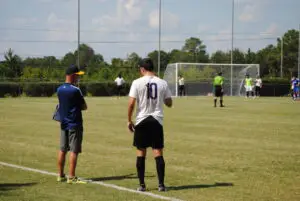 couldn’t get into four-year colleges or universities. In my first season we played against a player who would leave and sign a professional contract. Now we have four guys who will be representing the British Virgin Islands in the Caribbean Cup in just a few days and have five to six youth internationals coming in this fall.
couldn’t get into four-year colleges or universities. In my first season we played against a player who would leave and sign a professional contract. Now we have four guys who will be representing the British Virgin Islands in the Caribbean Cup in just a few days and have five to six youth internationals coming in this fall.
For our program we look to identify prospects that will have lots of big doors open to them after a two-year career at Andrew College and we use our relationships that we build with other coaches to help assist in those doors being there, provided the guy does what is required of him on and off the pitch.
The junior college route allows players who don’t meet the NCAA or NAIA academic eligibility requirements, but we don’t look to build our program on guys who haven’t proven academics as a priority. Building relationships with four-year coaches allows us to bring in guys for a year or two that another school can’t due to roster restrictions or possibly not meeting eligibility requirements.
Of the 142 schools that sponsor NJCAA Division I men’s soccer, the 2015 Andrew College was the second-most improved team according to the final NJCAA statistics. Andrew College posted a 10-8-0 record this season after going 2-16-0 in 2014. To what do you attribute that success?
Truly this is simple but not at the same time and something I could talk for hours about. The simple part is it comes down to pride, respect, discipline, dedication, commitment, sacrifice and hard work with a lot of fun.
Personally I hate losing and I have a lot of personal and professional pride in what I do. When I arrived right before the 2014 season 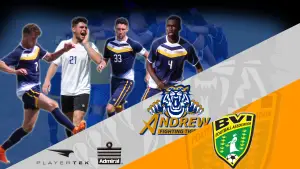 the program was broken. Coaches hadn’t stayed longer than a season and player identification hadn’t been done to any sort of good level. The equipment was very poor and there were not many players who had pride in what they did on and off the pitch. The players who were here didn’t seem to be for the right reasons, but to no fault of their own.
the program was broken. Coaches hadn’t stayed longer than a season and player identification hadn’t been done to any sort of good level. The equipment was very poor and there were not many players who had pride in what they did on and off the pitch. The players who were here didn’t seem to be for the right reasons, but to no fault of their own.
Putting a philosophy and business plan in place and sticking to what I call “Keys to Success” started to put us in the right direction. That wasn’t seen by many outside a small group in the first year but then in 2015 with the right guys representing the college and our program allowed us to make a transcendent turnaround. We set goals of being better and that wasn’t hard after being one of the worst teams in the nation for a decade. We accomplished that winning as many games as the previous three seasons combined.
Our player identification was crucial to the turnaround because at the end of the day, they are the reason. I can’t go out and play the games for them or go to class for them. They represent our program on and off the pitch. So we look for guys that will invest in the program.
I tell the guys several things over and over. Two of them apply to this. First it’s easy to buy a Honda because you feel it’s a quality car, but it’s a lot harder to buy a dealership. When you buy the Honda dealership then the product is important to you personally. The other is a quote by Ralph Waldo Emerson, “What you do speaks so loud that I cannot hear what you say.”
I learned from one of my mentors, Mac McBride at Notre Dame College (Ohio) a long time ago that he used with one of his first teams, “facta non verba.” This also means like the Ralph Waldo Emerson quote, actions not words. People can talk about being great or wanting to do something. Not many people are willing to put in the work that it takes or to follow through with a plan. There are a lot of talented individuals in every sport and career, but what separates the best from the rest is having the strength and drive to actually do something no one else is willing. When you find people who share this direction then you are headed in a very good one and that was the not so simple thing we accomplished with that first player identification cycle.
Can you share a creed, quote or philosophy you try to instill into your athletes?
There are seven “Keys to Success” with our program and with each is an associated quote. One of my favorites is Commitment and the quote by Jesse Owens, “We all have dreams. But in order to make dreams come into reality, it takes an awful lot of determination, dedication, self-discipline, and effort.”
Our philosophy is simple, you have to be willing to outwork everyone and make yourself the benchmark for determination, dedication and effort. No one else can give you the tools to be successful. I don’t think I am the most talented or best coach, not even close to be honest. But I control if anyone outworks me. The same goes for our players when they are in college and after when they are husbands, fathers, employees or employers and members of the community. That is what we try to instill in our guys.
What are some of the things you are currently doing with your program?
There are a lot of different things we are doing with our program to help separate ourselves from other college programs, both two-year and four-year.
The biggest thing we are doing is using technology to help us track players physical exertion and analytical stats. My desire is to run a college program that operates like a professional club. This allows us to prepare our players for the highest levels of the game and life. We have partnered up with PLAYERTEK a revolutionary GPS tracking system and became just the second college in the US to work with PLAYERTEK. Since that time PLAYERTEK has grown and we are able to easily send data on players to four-year college programs that also use them.
PLAYERTEK gives us the same scientific insight that professional players use daily to improve their game performance and to ensure the intensity of their regime. PLAYERTEK lets us track and record the physical stats from games, measuring everything from speeds to power using 10 different performance metrics.
Secondly we also partnered up with Videobserver a powerful tool to analyze player’s statistical performances. We are able to look for higher standards of efficiency and effectiveness in the analysis procedures. VO allows us to achieve this and is becoming an instrument that we will never want to be without. It helps our players become better and for our coaching staff to become better coaches too.
We use these measurements both physically and statistically to share with four-year coaches about the players. This allows us to not just show a highlight video and say that the guy meets the eye test but show real data on the type of player they are. Are they one with a big engine and are they a creative player or a safe one who never loses the ball.
PLAYERTEK and Videobserver give us the resources to be more informed about the players. In the near future we will be adding a specifically designed measurement in sport and exercise psychology by a research team at Virginia Tech. This will become a great tool for us to have a deeper layer of information on our players, their mindset and what motivates them. These tools are just some of the exciting and cutting edge things we are currently using, next year we may look to add something else as I am always looking at ways to improve the program each year.
Bonus Question: Is there anything important that you would like to share directly with high school athletes or soccer players in particular as they navigate the recruiting process?
I always tell prospects or in talks at events that making the decision as to what college they will attend and what coach they are going to play for is the biggest decision of their young lives … they are not married nor have they purchased a house. The process of finding the right fit can be misleading if they are not careful.
Coaches are in the business of finding the right players for their system. The coaches are experienced and know how to make people feel wanted. As I tell people at recruiting talks, “It’s like dating. The first time a coach speaks to you, or calls or emails it’s like the first time you hold hands in a relationship. There is a buzz of excitement and joy. But you have to think, ‘what is this coaching going to be like in 20 years? Is this someone I want to be with because of who they truly are, or are they just good looking and make me excited now?” It’s always funny the reaction I get from people because it’s such a different way of looking at it, plus it’s a bit of a harsh reality but doing the research on the coach and college is vital.
I work at placing guys at the right four-year program. I have a lot of personal experience to help guide and direct them. Life lessons only come with time. Players and parents are more educated now than when I went to college in the late 1990’s, but there is still a lot of unknown to those who don’t work in college athletics on a daily basis. Being critical thinkers and making a patient decision that isn’t based on emotion but real research from talking to current players and listening to how they say what they do is important.
Next, take a look Tuition and Student Debt Are Rising.
LIKE WHAT YOU READ?
Please take a moment to share it on social media, by clicking on the “sharing is caring” buttons below Coach Roediger’s profile.
Thanks,
Bryan
Profile:
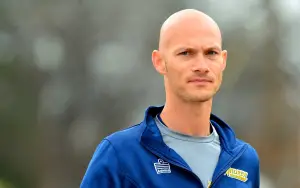 Coach Roediger has a uniquely diverse resume as a coach, technical director, athletic director, director of operations, sports information director and director of media relations at the interscholastic, intercollegiate, Premier Development League, Olympic Development Program, club and international levels.
Coach Roediger has a uniquely diverse resume as a coach, technical director, athletic director, director of operations, sports information director and director of media relations at the interscholastic, intercollegiate, Premier Development League, Olympic Development Program, club and international levels.
During his time at Andrew College, Roediger has gone about the task of rebuilding the 10-time Region 17 championship program back into a contender. That effort began paying dividends in his second season with his first recruiting class in 2015 as Andrew won 10 games, equaling the combined wins totals from the previous three seasons (2012, 2013, 2014).
Overall Andrew finished 10-8-0 in 2015 and was the second-most improved team in the nation, posting a win-loss improvement of +8. The Fighting Tigers more than doubled their number of goals (44 from 17) from the previous year, and the defense allowed 51 fewer (32 from 83) than the year prior. Under Roediger Andrew vaulted into the national stage when it defeated two teams earning votes in the National Junior College Athletic Association (NJCAA) Division I Men’s Soccer Coaches Poll. As a result, Andrew earned its first national ranking since 2004 and remained for three straight weeks. The Fighting Tigers ranked as high as No. 16 by both the NJCAA and the National Soccer Association of America (NSCAA) in 2015.
In 2015 Andrew players garnered eight end-of-the-season awards from the Georgia Collegiate Athletic Association (GCAA) and an NJCAA National Player of the Week under Roediger.
Since the conclusion of the season Andrew College men’s soccer All-Region 17 honorees Lewis Jones, James Quinn, Josh Fines and Troy Ceasar have been named to the British Virgin Islands Men’s National Team roster for the 2016 Caribbean Cup by BVIFA Head Coach Avondale Williams. The quartet of first-year Fighting Tigers will play in Group 7 of the First Round against Martinique and Dominica on March 22 and 26 respectively.
Roediger is no stranger to program rebuilding. Before becoming Andrew’s head coach, he served as an assistant coach at Bethany College (W.Va.), Bluefield College (Va.), and Montreat College (N.C.) where he was instrumental in immediate transformations through his player identification, organization and promotional efforts.
A year later Roediger was a driving force behind Montreat’s turnaround where his recruitment and organization helped guide the Cavaliers to their first Appalachian Athletic Conference runner-up finish since 2006.


